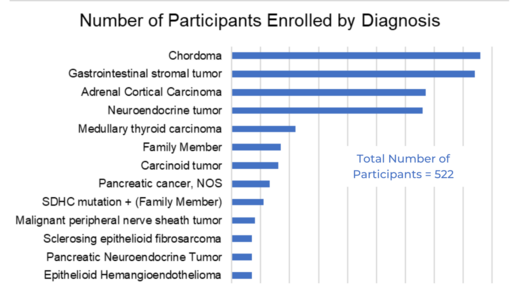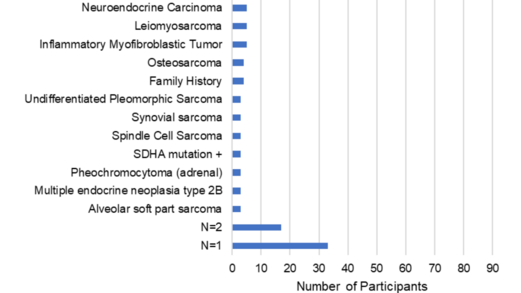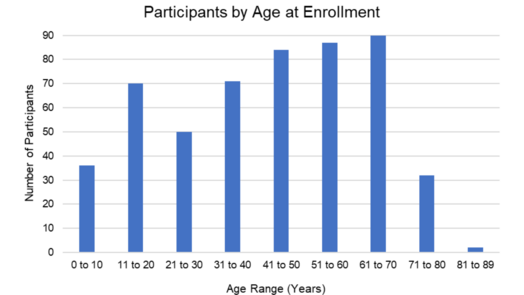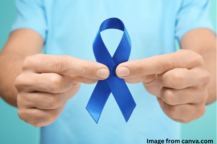|
The Natural History Study of Rare Solid Tumors has enrolled 522 participants as of March 2023 with over 75 different rare tumor diagnoses. The study opened for enrollment in January 2019 and continues to enroll people with rare solid tumors to gain an understanding of how these tumors grow and affect a patient’s quality of life through collecting and analyzing medical records and biospecimens and reviewing patient reported outcomes. Diagnoses representing only 1 or 2 participants are labelled N=1 and N=2 (respectively) below and make up almost 13% of all participants enrolled on the study.
View the graphs below to see the detailed breakdown of study participants by diagnosis and by age. Learn more about the study, the data we collect, and how to participate here.
   |

MIB Agents is a non-profit organization dedicated to “Making It Better” for the entire osteosarcoma community, from patients and caregivers to physicians and researchers. The idea for MIB Agents began in 2010 after Ann Graham, aged 43 and diagnosed with osteosarcoma, was receiving treatment for her cancer, and was inspired by the cheerful children who were also undergoing osteosarcoma treatment. Ann’s first mission to Make It Better for a childhood osteosarcoma patient was in 2012, when she helped provide an exciting and fun experience in New York City for a young osteosarcoma patient in hospice, and her family. From that first mission, MIB Agents has grown into an organization that supports the entire osteosarcoma community through programs, education, and research.
Since 2012, MIB Agents has been serving the osteosarcoma community and creating programs for patients and families. Programs include Prayer Agents for prayer requests, Warrior Mail, which provides letters and words of support for patients, and Ambassador Agents, which connects osteosarcoma survivors and families with current osteosarcoma patients. Programs for family members include Gamer Agents, which allows survivors, current patients, and family members to bond through online gaming, and Healing Hearts, a community for parents who have lost their child to osteosarcoma.
MIB Agents also provides a variety of educational resources, including OsteoBites, a weekly webinar and podcast open to the public that shares the latest research and advances in osteosarcoma. The OsTEAo podcast, hosted by two adolescent/young adult (AYA) osteosarcoma survivors, is a resource for those interested in all things osteosarcoma and AYA cancer. The MIB Agents website provides osteosarcoma resources in three languages (English, Spanish, and Chinese) and enables visitors to search osteosarcoma clinical trials. The website also hosts the MIB Agents Testing and Research Directory, which informs patients of potential laboratory tests and research options that may help inform their treatment plan. For physicians and researchers treating and studying osteosarcoma, MIB Agents hosts TURBO, an international virtual tumor board. MIB Agents also supports osteosarcoma research efforts and facilitates collaboration and innovation through its annual FACTOR osteosarcoma conference.
Since 2017, MIB Agents has supported osteosarcoma research through the OutSmarting Osteosarcoma research grant. Collaboration among the scientific and patient community is a key hallmark of MIB Agents. MIB Agents OutSmarting Osteosarcoma grants are supported by MIB Agents Family Funds, osteosarcoma patients and families who have raised funds in honor of an OsteoWarrior or OsteoAngel. Their dedication to Making It Better and fostering collaboration and education in the scientific community makes every MIB Agents award incredibly meaningful. OutSmarting Osteosarcoma is a partnership on many levels - between the researchers who do the work and the funders who make it possible, and between the scientific reviewers who evaluate the science, and the stakeholders who weigh in on patient impact. From 2017 to 2022, MIB Agents has funded $950,000 in grants supporting eleven investigators, including young investigators.
MIB Agents is committed to supporting every member of the osteosarcoma community, from patients and families to healthcare providers and researchers, with the goal to improve the lives of young people with osteosarcoma and advance research and awareness of osteosarcoma. MyPART is excited to welcome MIB Agents as an advocacy partner!
Learn more about MyPART Advocacy Partners here.
|

Neurofibromatosis is a collection of three genetic conditions: neurofibromatosis type 1 (NF1), NF2-related schwannomatosis (NF2), and schwannomatosis. While NF1, NF2, and schwannomatosis are caused by genetic changes in different genes, all three conditions can lead to the development of tumors throughout the nerves in the body. Tumors that may form as the result of neurofibromatosis can be difficult to treat and remove and may lead to a host of different symptoms depending on where the tumors are growing in the body. Every person with neurofibromatosis is affected differently. Some people experience very few symptoms, while others live with tumors that may affect their movement, appearance, vision, or hearing.
NF1 is the most common form of neurofibromatosis, affecting about 1 in 3,000 people, and is caused by mutations in the gene NF1, originally discovered at the NIH in 1990 by the lab of Dr. Francis Collins. NF1 can cause tumors, called neurofibromas, to form on nerves throughout the body. One type of neurofibromas, called plexiform neurofibromas, are often present during infancy and can lead to a number of challenges. While plexiform neurofibromas are benign (not cancer), they can grow relatively quickly, particularly in young children. Plexiform neurofibromas may cause disfigurement, limit mobility, or impinge on various organs and structures in the body. They can be difficult to remove with surgery. In rare cases (about 8 to 13% of people with NF1), NF1 can lead to the development of malignant peripheral nerve sheath tumors, which are aggressive, cancerous tumors that can spread to other parts of the body. The NCI Pediatric Oncology Branch (POB) has been committed to studying NF1 related tumors for over 25 years. In 2008, POB opened a natural history study to learn more about how NF1 progresses in patients. Over 14 years later, this study is still ongoing and continues to aid our understanding of the disease. In the years following the opening of the natural history study, Dr. Brigitte Widemann and a large team opened a clinical trial studying the safety and efficacy of the MEK inhibitor selumetinib in pediatric patients with NF1 and inoperable plexiform neurofibromas. Around 70% of patients experienced tumor shrinkage. Further, patients reported less pain, increased mobility, and overall improved quality of life. Selumetinib was granted breakthrough designation by the US Food and Drug Administration (FDA) and was ultimately approved by the FDA in April 2020. Selumetinib is the first FDA approved treatment for children 2 years and older with NF1 and inoperable, symptomatic plexiform neurofibromas and is now approved in other countries around the world. Today, the team is expanding their studies to include adults with NF1 and to see if treating tumors before they become symptomatic will help prevent tumor growth and tumor related problems. To learn more about our NF team, visit the POB website here.
May is an opportunity to spread awareness of neurofibromatosis and reflect on the diversity of the neurofibromatosis patient experience. Learn more about Neurofibromatosis Awareness Month here.
|
|